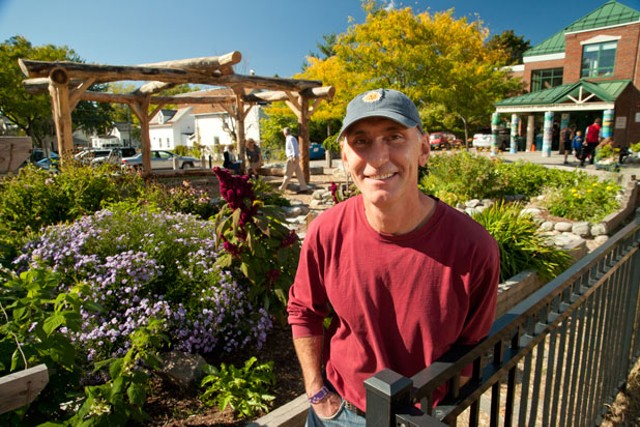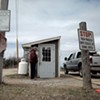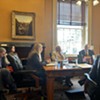Published September 26, 2012 at 9:46 a.m.
On a recent Friday morning, kindergarten students at the Sustainability Academy at Lawrence Barnes in Burlington pack into the new outdoor classroom on the Old North End school grounds. Today’s lesson has students learning about shapes, and most clutch colorful construction-paper cutouts of circles, squares and triangles as their feet dangle from logs fashioned into benches.
“You need to put on your ‘owl eyes’ and be really observant scientists,” says teacher Julie Benz, before turning the students loose to hunt for shapes.
They take her directive to heart. “I found a triangle!” exclaims one small boy, pointing at the roof of a little butterfly house perched in the “ABC Garden,” which kindergarteners at the school planted a few years ago. A grasshopper perched on a blossom momentarily distracts other students, but with some gentle nudging from teacher Sue Blair, they begin identifying the insect’s shapes — its circular eyes, its rectangular body.
Command central for Friday’s “outside day” — the kindergarteners’ favorite day of the week — is the new outdoor classroom erected in the heart of the school yard. It’s less a traditional classroom than it is an open-air veranda, fashioned from the bark-stripped trunks of enormous Vermont larches that rest on boulders serving as foundation stones.
That new learning area isn’t the only change on the grounds. A tiny amphitheater of log benches on the east side of the school serves as an activity space for kindergarteners. The gardens, planted and tended by students, are lush and green. Just as healthy, many parents say, is the Lawrence Barnes School — thanks to an adventurous magnet program and the energetic leadership of interim principal Brian Williams.
Just a year and a half ago, says parent Mark Cline Lucey, the outdoor area was a “bleak, urban school grounds.” These days, though, “it’s transforming into an oasis in the middle of the Old North End — a place where community members, even if they don’t have children at the school, want to come spend time,” Cline Lucey says. “The children want to spend time outside. It feels nourishing.”
The changes to the grounds may seem like a cosmetic upgrade, but the school’s biggest champions argue they’re indicative of much more. “We were stuck in a rut,” says Tiffany Tillman, a parent volunteer. The school’s leaders decided that it needed a dramatic change — something people could see, and a place where students could be outside and learn.
Now, a year into Williams’ tenure, Barnes is bustling with new energy. “He is the kind of principal who … can make those things a reality,” Tillman says. “All of a sudden, people feel like we can get things done.”
“I’ve never known anybody who makes things happen the way [Williams] can,” Cline Lucey says. “He’s a doer and a visionary, and it’s so rare to have both of those together.”
What’s especially remarkable is just how swiftly and dramatically this school is changing. Not long ago, 95 percent of students at the Lawrence Barnes School lived in poverty, compared with about 48 percent district wide. A former Burlington School District superintendent was in favor of closing Barnes altogether and bussing students across the district.
The school survived the chopping block because of an innovative program: When it opened as a magnet school in 2009, Barnes became the first sustainability-themed elementary school in the country. But it wasn’t all smooth sailing after that. For one thing, the theme was hard to explain — “everyone has their own definition of sustainability,” points out BSD superintendent Jeanne Collins.
Then Abi Sessions, the academy’s first principal after it transitioned to a sustainability-themed magnet school, left after just two years on the job; her departure coincided with an investigation into allegations made by an African American mother who said her young son had been mistreated after accidentally urinating on the playground. The incident, Collins says, left some members of the community mistrustful of the school.
Williams stepped into this environment last year; he’s now entering the second year of a two-year contract as interim principal, and he’ll have the option to apply for the permanent job.
Williams makes time to speak with a visitor to the outdoor classroom even as he orchestrates preparations for a community open house, just hours away, where the school expects to feed some 300 visitors. “Do you think 30 pounds of pasta will be enough?” he asks during one break in the conversation. When the school day ends and students careen across the school yard, Williams’ own kindergartener, Eleanor, comes skipping across the courtyard for a hug.
It was Williams, along with Burlington High School art teacher Chris Sharp, who brought the outdoor classroom to life after six weeks of “full tilt” construction this summer. That followed months of community design charettes and input from teachers and students. Seventh Generation funded the $7000 project, but it required a heavy dose of volunteer labor and creative engineering solutions.
“We couldn’t afford a crane, so we had to use the district’s forklift,” Williams says, gesturing to the massive beams that form the latticework of the classroom’s roof.
Sharp and Williams started teaching at the high school together 22 years ago, Sharp in the art department and Williams in English. Their friendship was one incentive for Sharp to pitch in on the outdoor classroom project. He also has a deep connection to Barnes: Sharp, now 47, attended elementary school there. The school hasn’t changed much in appearance, he says — the same seemingly indestructible green tiles line the hallways. What does feel markedly different, Sharp says, is the spirit of the place.
“I grew up in the Old North End, and I know that it’s oppressive to live in an environment without hope,” he says. But today? Sharp speaks with infectious enthusiasm about the transformation of his childhood school.
“This isn’t just a school. It’s a model of what change in a school can be,” he says. “This is the most vibrant change I’ve ever seen made in a school.”
Cline Lucey agrees. “It’s so much more than just this outdoor classroom,” he says. “What’s happening at the Sustainability Academy is vanguard. It’s where we’re going to have to see more and more schools moving.”
Already the magnet school is showing gains. It’s diversifying economically; currently, about 70 percent of students live in poverty, down from 95 percent before the magnet program. Test scores are inching up, and this year the first class of kindergarteners to enter the program — now third graders — will sit for the New England Common Assessment Program standardized exam.
There are still challenges to face. “Resources are very limited,” says superintendent Collins, though grants have supported the innovative work at Barnes. And the school is small: With more than 200 students, it’s now at capacity, which limits the number of pupils who can participate in the academy. And the school district is trying to answer the question “What next?” A new committee nicknamed “Magnets in the Middle” is looking for ways to extend the magnet-school ethos inculcated at the Integrated Arts and Sustainability academies into the middle-school years.
Meanwhile, though, more and more parents — especially those in the Old North End — are singing Barnes’ praises.
For Cline Lucey, an educator at the independent Vermont Commons School in South Burlington, the choice to send his second-grade son to Barnes had two strong motives. First, it’s the family’s neighborhood. Second, Cline Lucey considers himself deeply committed to place-based and service learning, basic tenets of the Vermont Commons School.
He admits that the concept of sustainability isn’t as easy to pitch as, say, that of the Integrated Arts Academy, Burlington’s other magnet elementary school. Everyone understands how art and education fit together — but sustainability?
“People’s minds obviously turn immediately to environmental sustainability,” Cline Lucey says. They think “recycling” or “compost.” In reality, what the Sustainability Academy is teaching are much broader concepts of economic and environmental sustainability and social equity.
“They’re not just learning about nature every day,” Cline Lucey adds. “They’re taking walks around the Old North End with their classes, and they’re asking themselves, ‘What would make this an even nicer community to live in?’”
And then, even more impressively, students are learning how to make changes. “It’s not just saying, ‘Oh, it’d be nice to have a stop sign there,’” Cline Lucey says. “It’s then going to the city offices and making a proposal … It’s a pedagogy of empowerment for the kids.”
What’s most “magical” about all of this, he says, is that it’s happening at a school like Barnes — an urban, public elementary school grappling with poverty.
Perhaps happiest of all — about the recent upgrades to the school’s outdoor space in particular — are the students. On a recent “outside day,” the kindergarteners clamber onto the wooden benches of the outdoor classroom and eagerly await their morning snack: a crisp, local Macintosh apple for each child. “I feel like they’re proud of their space,” says Benz, one of the two kindergarten teachers.
And the students do seem delighted by the structure. Williams notes that when the school unveiled its latest addition, some students asked, adorably wide-eyed, “Is this for us?”
After school, a few kids perch on the benches to speak to a reporter. “It took us a long time to build this thing,” second grader Lucia Clark says earnestly. And when it was finished, she continues, “We finally tried it out, and nothing broke.”
More By This Author
About the Artist

Matthew Thorsen
Bio:
Matthew Thorsen was a photographer for Seven Days 1995-2018. Read all about his life and work here.
Matthew Thorsen was a photographer for Seven Days 1995-2018. Read all about his life and work here.
Speaking of...
-

Lt. Gov. Zuckerman Goes on a 'Banned Books Tour'
Sep 6, 2023 -

UVM Hillel Provides Shabbat Meal Kits With Student-Grown Vegetables
Aug 29, 2023 -

Heather Moore, New Executive Director of Shelburne Craft School, Is Learning on the Job
Aug 31, 2022 -

Vermont Officials Release Relaxed COVID-19 Guidance for the School Year
Aug 24, 2022 -

Back to School During Delta: A Pediatrician With Young Children Offers a Road Map — and Survival Strategies
Aug 24, 2021 - More »
Comments
Comments are closed.
From 2014-2020, Seven Days allowed readers to comment on all stories posted on our website. While we've appreciated the suggestions and insights, right now Seven Days is prioritizing our core mission — producing high-quality, responsible local journalism — over moderating online debates between readers.
To criticize, correct or praise our reporting, please send us a letter to the editor or send us a tip. We’ll check it out and report the results.
Online comments may return when we have better tech tools for managing them. Thanks for reading.















































